Giraffes seem above it all. They float over the savanna like two-story ascetics, peering down at the fray from behind those long lashes. For decades, many biologists thought giraffes extended this treatment to their peers as well, with one popular wildlife guide calling them “aloof” and capable of only “the most casual” associations.
But more recently, as experts have paid closer attention to these lanky icons, a different social picture has begun to emerge. Female giraffes are now known to enjoy yearslong bonds. They have lunch buddies, stand guard over dead calves and stay close with their mothers and grandmothers. Females even form shared day care-like arrangements, called crèches, in which they take turns babysitting and feeding each others’ young.
Observations like these have reached a critical mass, said Zoe Muller, a wildlife biologist who completed her Ph.D. at the University of Bristol in England. She and Stephen Harris, also at Bristol, recently reviewed hundreds of giraffe studies to look for broader patterns. Their analysis, published on Tuesday in the journal Mammalia, suggests that giraffes are not loners, but socially complex creatures, akin to elephants or chimpanzees. They’re just a little more subtle about it.
Dr. Muller’s sense of giraffes as secret socialites began in 2005, when she was researching her master’s thesis in Laikipia, Kenya. There to collect data on antelopes, she found herself drawn to the ganglier ungulates. “They are so weird to look at,” she said. “If somebody described them to you, you wouldn’t believe they even really existed.”
After noticing that the same giraffes tended to spend time together — they looked “like teenagers hanging out,” she said — Dr. Muller started to read up on their lifestyles. “I was really surprised to see that all the scientific books said that they were completely non-sociable,” she said. “I thought, ‘Well, hang on. That’s not what I see at all.’”
In an ecosystem full of trumpeting elephant matriarchs and fast-paced cooperative lion hunts, it makes sense that the complexities of giraffe sociality have been harder to spot, said Kim VanderWaal, an associate professor at the University of Minnesota who has also studied them. Giraffes don’t communicate in ways that are obvious to us, and live quiet social lives low on visibly pally behaviors like grooming or cooperative territorial defense. The use of digital cameras, which help with tracking individuals by spot pattern, and social network analysis, which can reveal hidden associative patterns, have made it easier to tease out their relationships.
Giraffe society seems to be built around strong pair bonds, especially between mothers and their young, which coalesce into kinship groups, Dr. Muller said. Watching females stay close to the body of a deceased calf for many days, forgoing food and water, drove home for Dr. Muller “how strong the attachments could be within a group,” she said.
But it’s been difficult to budge their detached reputation, she said.
For this latest paper, she and Dr. Harris reviewed over 400 studies, pulling together all of the evidence. The result is “a solid scholarly review,” and supports the idea that “giraffe societies are way, way more complex than most biologists think,” said Fred Bercovitch, a conservation scientist at the Anne Innis Dagg Foundation, who was not involved with the study.
It also lays out a number of avenues for further research. While reading through the studies, Dr. Muller noticed that giraffe females tend to live long past their childbearing years. In other socially complex animals, including humans and killer whales, post-reproductive individuals help younger generations thrive by providing wisdom and care.
This phenomenon, called the grandmother hypothesis, should be tested in giraffes, Dr. Muller said. If it’s true, this would have conservation implications, as older giraffes are often culled or trophy hunted. It would also provide more evidence that giraffes experience sophisticated forms of fellowship. The existence of those calf-care crèches might even qualify giraffes as cooperative breeders, like beavers or scrub jays, Dr. Muller said.
Others are more cautious. “Giraffe social structure is complex,” and researchers are just beginning to understand it, said Dr. VanderWaal, who was also not involved in the study. “I think more research is needed before we conclude that giraffes live in cooperative societies.”
But all agree that we should continue craning our necks until we have a better view. Giraffes are “one of the most recognizable animals in the world,” Dr. Muller said. “And we’re only just starting to scratch the surface.”
Source: Read Full Article


